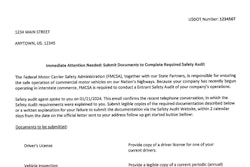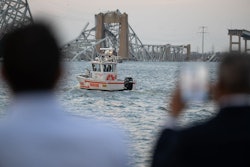Trucking news and briefs for Wednesday, June 12, 2024:
'Brake Safety Day' inspection blitz hit 5,000 vehicles all told, but date remains undisclosed
Inspectors in 47 jurisdictions throughout the U.S., Canada and Mexico conducted nearly 5,000 inspections in one day as part of the Commercial Vehicle Safety Alliance’s Brake Safety Day inspection and enforcement event.
Each year, CVSA law enforcement jurisdictions are invited to participate in the one-day, unannounced brake-safety inspection initiative. On that day, CVSA-certified commercial motor vehicle inspectors conduct their routine roadside inspections with a focus on brake systems and components, and provide brake-related inspection and violation data to CVSA. The unannounced blitz happens every spring, but CVSA kept a tight lid on the day, at least this year, not including it in the press materials around this year's results. The 2023 event was held April 19.
This year’s Brake Safety Day data found that of the 4,898 inspections conducted, 4,328 commercial motor vehicles did not have any brake-related out-of-service violations -- 88.4% of the total number of vehicles inspected.
However, inspectors identified 570 (11.6%) commercial vehicles with brake-related critical inspection item vehicle violations. Those vehicles were immediately placed out-of-service until the critical violations could be properly addressed.
Inspectors identified 330 commercial motor vehicles with 20% brake violations, meaning 20% or more of the vehicle’s service brakes had an out-of-service condition resulting in a defective brake. That was the top Brake Safety Day violation, accounting for 57.9% of all brake-related out-of-service violations.
Inspectors found other brake violations on 256 (44.9%) of the commercial motor vehicles inspected. Examples of other brake violations include worn brake lines/hoses, broken brake drums, an inoperative tractor protection system, inoperative low-air warning device, air leaks, hydraulic fluid leaks, etc.
Seventy-three commercial motor vehicles had steering-related brake violations -- 12.8% of all brake-related out-of-service violations.
[Related: Brake Safety Week nets 5,000 out-of-service violations]
This year, emphasis was placed on brake lining/pad health and safety -- the same focus of the upcoming Brake Safety Week. Brake lining/pad issues may result in violations or out-of-service conditions and may affect a motor carrier’s safety rating. Inspectors found 108 power units and 66 towed units with lining/pad violations.
A total of 114 brake lining/pad violations were discovered on power units. The top brake lining/pad violation on power units was for contamination, with 48 violations. Seventy-one brake lining/pad violations were identified on towed units, with 23 of those for cracks/voids in the linings/pads -- the top brake lining/pad violation on towed units.
Nine U.S. jurisdictions with performance-based brake testers (PBBT) utilized them during Brake Safety Day for a total of 88 PBBT inspections conducted on Brake Safety Day. Only four (4.5%) failed to meet the 43.5% minimum braking efficiency required and were placed out of service.
[Related: Brake Safety Week dates set with focus on brake linings, pads]
Ohio warns of delays as ‘super load’ moves across state
The 12th of nearly two dozen “super loads,” and first of four loads that exceed 900,000 pounds, will depart a dock site in Adams County, Ohio, east of Cincinnati, on Sunday, June 16. The convoy will head to New Albany to deliver the load to the site of the new Intel plant in Licking County.
This load, an air processor known as a cold box used in the silicon chip manufacturing process, measures approximately 23 feet tall, 20 feet wide, 280 feet long, and weighs 916,000 pounds.
The move is scheduled to take more than a week. It will make stops in West Portsmouth, Lucasville, Waverly, Chillicothe, Rickenbacker, Groveport, Pickerington and Pataskala, before being delivered on Tuesday, June 25. Complete route details can be found here.
These extra-large loads will have significant traffic impacts as they move, according to the Ohio DOT. Drivers are strongly encouraged to plan ahead and avoid the route while the load is moving.
Due to the size of the loads and slow speed of the convoy, moves will begin early to ensure each move can be completed during daylight hours.
Because of an anticipated increased interest from the public, large crowds are also expected along the route, leading to additional traffic delays.
Notifications will be made in advance of each load leaving the dock on the Ohio River near the village of Manchester in Adams County. Updates will be provided as each load moves north toward central Ohio.
[Related: The heaviest of hauls: Peek into 2022's biggest, baddest jobs by specialized carriers]
FMCSA planning truck driver seat belt survey
The Federal Motor Carrier Safety Administration is seeking approval for an information collection request (ICR) to survey commercial vehicle drivers to understand their perceptions and behaviors regarding safety belt usage and road safety.
The agency said that “existing data on the usage of safety belts and perceptions related to road safety do not capture the diversity of different types of CMV drivers in a post-coronavirus disease 2019 national emergency landscape.”
The survey, FMCSA added, will help “in gauging emerging trends among this cohort and will inform future messaging and communication efforts targeting CMV drivers.”
FMCSA will ask U.S.-based, self-identified CMV drivers to participate in an online survey. The results are not intended to be disseminated to the public, and information gathered “will not be used for the purpose of substantially informing influential policy decisions,” the agency noted.
While the White House Office of Management and Budget (OMB) reviews FMCSA’s request, the agency asks the public for comment on whether the survey is necessary for the performance of FMCSA’s functions; ways for FMCSA to enhance the quality usefulness, and clarity of the collected information; and more. Comments can be filed beginning Thursday, June 13, at www.regulations.gov by searching Docket No. FMCSA-2024-0091.
Channel to Port of Baltimore fully reopened to original dimensions
 The U.S. Army Corps of Engineers and U.S. Navy Supervisor of Salvage and Diving have worked to clear the channel to allow it to fully reopen at its original operating dimensions.U.S. Army Corps of Engineers, Baltimore District
The U.S. Army Corps of Engineers and U.S. Navy Supervisor of Salvage and Diving have worked to clear the channel to allow it to fully reopen at its original operating dimensions.U.S. Army Corps of Engineers, Baltimore District
The Fort McHenry Federal Channel leading to the Port of Baltimore has now been restored to its original operational dimensions of 700 feet wide and 50 feet deep for commercial maritime transit, the U.S. Army Corps of Engineers announced this week.
As a result, the Port of Baltimore is expected to return to full operations.
Since March 26, the U.S. Army Corps of Engineers and U.S. Navy Supervisor of Salvage and Diving worked to clear Key Bridge wreckage and move the cargo ship, the Dali, from the channel. Following the removal of wreckage at the 50-foot mud-line, a survey of the channel was performed June 10, certifying the riverbed as safe for transit. Surveying and removal of steel at and below the 50-foot mud-line will continue to ensure future dredging operations are not impacted.
The Unified Command safely moved the Dali on May 20 and widened the limited access channel to 400 feet May 21, permitting all pre-collapse, deep-draft commercial vessels to transit through the Port of Baltimore. Now, the fully operational channel enables the flexibility to regain two-way traffic and cancel the additional safety requirements that were implemented because of the reduced channel width.
Fully restoring the channel to its original width and depth involved the removal of about 50,000 tons of bridge wreckage from the Patapsco River.
“We’ve cleared the Fort McHenry Federal Channel for safe transit. USACE will maintain this critical waterway as we have for the last 107 years,” said Col. Estee Pinchasin, Baltimore District commander. “I cannot overstate how proud I am of our team. It was incredible seeing so many people from different parts of our government, from around our country and all over the world, come together in the Unified Command and accomplish so much in this amount of time,” about two months all told.
[Related: Limited HOS waivers for Baltimore bridge collapse extended]








